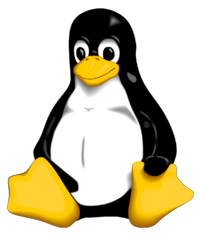Linux (operating system): Difference between revisions
imported>Joshua David Williams m (minor white space problem) |
imported>Eric M Gearhart m (Fixed shell) |
||
| Line 58: | Line 58: | ||
|sbin || Houses the binaries necessary to the system, such as disk mounting tools | |sbin || Houses the binaries necessary to the system, such as disk mounting tools | ||
|---- | |---- | ||
|usr || Contains the majority of the program binaries, as well as [[shell (software)|shell] commands | |usr || Contains the majority of the program binaries, as well as [[shell (software)|shell]] commands | ||
|---- | |---- | ||
|var || Slightly miscellaneous, this directory normally holds system logs and the [[HTTP]] directory | |var || Slightly miscellaneous, this directory normally holds system logs and the [[HTTP]] directory | ||
Revision as of 16:17, 6 April 2007
Linux is a Unix-like, open source operating system, notable for the fact that it is developed and improved upon through a community effort, originally written by Linus Torvalds. Although it was first developed for the Intel i386 architecture, it has since been ported to more systems than any other operating system, from the Intel i686 and AMD64 to the Xbox and Sparc systems.
Although it has traditionally been a popular server environment, Linux has recently grown in popularity among desktop users, thanks to the vast improvements of usability that the bundles of software, known as Linux distributions, have provided.
Naming
The original name 'Linux' came from the author's name, Linus, along with the "x" in Unix, to show that it is Unix-like. Linus originally intended to call the project "Freax", for Free and Freak, with the "x" denoting that it is Unix-like, but after one of his colleagues named the system's FTP directory after him, the name stuck.[1]
GNU/Linux naming controversy
In 1984, The Free Software Foundation, founded by Richard M Stallman, made an attempt to create a free Unix-like operating system, which they called the GNU system.[2]
They began with the necessary tools for the system, such as a compiler, debugger, and a text editor. Their plan was to then create a kernel to place beneath the tools that they had created. Unfortunately, the foundation was very late in producing a stable release, and even to this day development of the HURD (the GNU kernel) continues without a stable first release.
It was during this time that Torvalds first introduced his kernel. Before Linux, hackers had no choice but to use non-free kernels, most notably Minix. While the GNU kernel began to look more and more like vaporware every day, the community received Linux with open arms and many began to contribute.
From gnu.org: "Variants of the GNU operating system, which use the kernel called Linux, are now widely used; though these systems are often referred to as “Linux”, they are more accurately called GNU/Linux systems."
The GNU Project members decided to call 'Linux' GNU/Linux, in order to attribute credit to those who worked hard at creating the tools that the Linux kernel runs. Torvalds, however, has made no effort to hide his thoughts towards this naming convention, saying that "calling Linux in general just 'GNU/Linux' I think is ridiculous."[3]
Pronunciation
Linux is pronounced like 'Minix' - that is, "'li' is pronounced with a short [ee] sound: compare prInt, mInImal etc.'nux' is also short, non-diphtong, like in pUt."[1]
File system
As a Unix-like system, Linux maintains a hierarchical set of directories and permissions. Each file contains three basic permissions: read, write, and execute. Each directory and file is owned by a user account of the system and a (optional) group of users, and permission may be given to allow other users and groups to access the files as well, but only if the owner chooses to do so. This system is, while somewhat complicated, is very efficient, and has stood the test of time as a great prevention of malware.
The Linux kernel contains many directories. The following is a list of some of the most common:
| Directory | Contents |
|---|---|
| bin | Contains essential commands, such as bash, cp, and rm |
| dev | Every device connected to the computer is held here, such as hard disks, wireless adapters, system memory, and so on |
| etc | Contains global system configurations, such as the X.org settings |
| home | Root of the user folders; contains documents and personalized settings for each individual |
| lib | Libraries called upon by the system applications; a collection of functions that are not specific to any one program alone |
| root | The home folder for the superuser |
| sbin | Houses the binaries necessary to the system, such as disk mounting tools |
| usr | Contains the majority of the program binaries, as well as shell commands |
| var | Slightly miscellaneous, this directory normally holds system logs and the HTTP directory |
Distributions
Linux is typically found as a package of software known as a Linux distribution, also commonly referred to as a "distro". A Linux distribution provides an easy method of installing a Linux system. Distributions come in many forms, from LiveCDs, which extract the system onto a mounted sector of memory, to full installation DVDs. Among the most notable are Ubuntu, RedHat, and SUSE.
Software
Aside from the GNU project's applications, Linux is capable of running many applications of all natures, from games and graphic editors to Integrated Development Environments and web servers. Among the most commonly used applications are The GIMP photo editing tool, which is commonly referred to as a free alternative to Photoshop, Firefox, a very powerful, tabbed web browser, and OpenOffice, which is a free, full-featured alternative to the Microsoft Office suite.
References
- ↑ 1.0 1.1 USENET post on Linux naming (Retreived 06 April 2007).
- ↑ About the GNU Project (Retreived 06 April 2007).
- ↑ The "GNU/Linux" and "Linux" Controversy (Retreived 06 April 2007).
